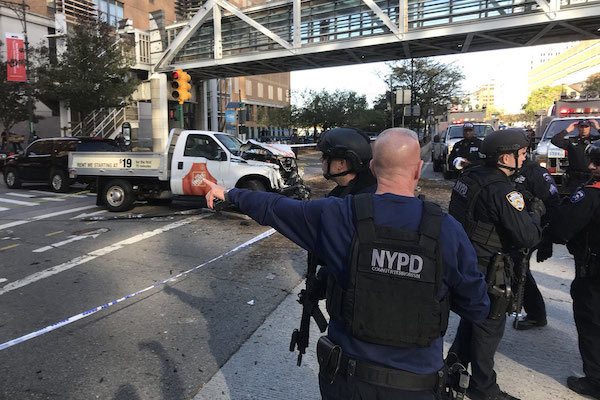In light of the recent lethal vehicular attack in New York City on October 31 2017, it is perhaps helpful to gain some sense of its use as a weapon over the past several years. After all, the English-language propaganda emanating from both the so-called Islamic State and al-Qaida have urged such an attack method.

This year alone, several similar attacks have occurred in Western cities, such as Barcelona (Spain), Stockholm (Sweden), and Edmonton (Canada) and thrice in London (United Kingdom).[1]
Prior to 2017, the number of post-9/11/01[2] vehicular attacks (excluding bomb-laden vehicles), numbered approximately 128, of which 48 (38%) featured an additional weapon type (referenced here as a combined arms attack). The total deaths produced by the 128 attacks was about 344, whereas the total number of wounded was approximately 1,289.
Excluding combined arms attacks, post-9/11/01 vehicular attacks (again, not involving bomb-laden vehicles) numbered approximately 80 (62%). The share of deaths associated with this limited attack type numbered 77 (22%) and the number of wounded was about 314 (24%).
The significance of these statistics is that when vehicular attacks occur, they are most devastating when combined with an additional weapon type. Specifically, while combined arms attacks featuring a vehicle represented only 38% of vehicular attacks, they produced 78% of the deaths and 76% of the injuries, on a global scale.
Regional Vehicular Attacks: Post-9/11 through 2016
Post 9/11 through 2016, only 23 (18%) of the attacks were against Western cities, whereas approximately 57 (45%) occurred in the Israel/West Bank/Gaza Strip[3] battlespace, most of which began in 2014 and rose exponentially over 2015 and 2016.[4]
Outside of that specific conflict dyad and beyond Europe and North America, the numbers are somewhat sparse. Hence, the remaining 48 (37%) of post-9/11/01 (non-explosive) vehicular attacks, occurred in the countries, listed alphabetically in the graph below.![Image Number of Vehicular Attacks Worldwide [Lima Charlie News]](https://limacharlienews.com/wp-content/uploads/2017/11/Graph-Vehicular-Attacks-Worldwide-Post-9-11.jpg)
Vehicular Attacks by Year: Post-9/11/01 through 2016[5]:
As the above table indicates, the trend has been upward in terms of global vehicular attacks. One might notice the trendline in 2015 having spiked at 44 and to a lesser degree in 2016 at 24. The simple explanation for that sharp rise is that 35 (80%) occurred within the Israeli-Palestinian conflict dyad. Similarly, for the 2016 data, exactly half of the attacks occurred between the exact same adversaries.
![Image Injured people are assisted after the attack on Westminster Bridge [Toby Melville/Reuters]](https://limacharlienews.com/wp-content/uploads/2017/11/Injured-people-are-assisted-after-the-attack-on-Westminster-Bridge-Toby-MelvilleReuters.jpg)
As more evidence continues to emerge regarding the alleged killer’s connection to any international organization and the full scope of his planning sequence, one apparent fact stands out: he exited his vehicle with simulated firearms. A similar modus operandi was used in 2017 in the events in London and Barcelona, where the assailants wore fake suicide vests. One might infer from this specific sub-trend that the attackers intend to die in a “suicide-by-cop” scenario. However, it is possible that in future events of this tragic sort, it may also become part of a diversion that draws attention to one individual, while another is actually armed with a lethal weapon.
When simulated weapons are brandished, they are treated as real. This is especially so when one has already demonstrated the capacity to inflict lethal harm with another weapon type; vehicles included. The law enforcement community trains to detect a multitude of threats, eliminating the closest (or most dangerous) ones, while scanning for the next.

In light of what was a very complex situation, for which the potential release of an array of 911 calls will likely reveal, the NYPD seems to have executed their task with a great deal of due diligence in this instance. Predicting when and where an attack will take place is a difficult, some might say impossible, task. However, vigilance on the part of civilians and law enforcement is surely an ingredient for reducing the additional damage caused by dedicated murderers.
David Firester, Lima Charlie News
David Firester, Lima Charlie’s Associate Editor and Intelligence & National Security Correspondent, is the founder and CEO of TRAC Intelligence, LLC. He is also a combat veteran, who held three Military Occupational Specialties in the U.S. Army and has served in a variety of domestic law enforcement roles. He holds advanced degrees in political science and serves as an adjunct instructor at Baruch College in New York City. Contact David @ dfirester@limacharlienews.com
Lima Charlie provides global news, insight & analysis by military veterans and service members Worldwide.
For up-to-date news, please follow us on twitter at @LimaCharlieNews
Sources
[1] For some details of previous attacks, see “A look at attacks where vehicles have been used as weapons.” ABC News online, October 31, 2017; accessible at http://abcnews.go.com/International/wireStory/attacks-vehicles-weapons-50847984.
[2] The reason for using 9/11/01 as a cut-point are two-fold. The data prior to that date was mostly acquired from Pinkerton Global Intelligence Services and details were very sparse. Secondly, the attacks on 9/11/01 were coded as vehicular, where airplanes were used in the most devastating attack of its type. Thus, excluding 9/11/01 from the dataset is a means for reducing data that would bias the overall figures. Pre-9/11/01 attacks featuring vehicles alone numbered about 31 from 11/1/1970 and in combination (combined arms) was about 53.
[3] The database from which these figures were drawn has only “Israel” and “West Bank/Gaza Strip.” Hence, I combine both to encompass the dichotomous relationship within which the conflict occurs. The database does not use terms such as “Palestine,” nor does it use “Judea and Samaria” for the “West Bank” region. In fact, faulty as it is, the database sometimes confuses areas within the “West Bank” for areas that might lay on the other side of the 1967 armistice lines. I have addressed this issue elsewhere. See “Potentially Misleading Statistics on Global Terrorism,” Firester, David. The Jerusalem Post. July 1, 2016; accessible online at http://www.jpost.com/Blogs/Tracking-the-Threat-Stream/Potentially-Misleading-Statistics-on-Global-Terrorism-459236. Also, see “What Does the Global Terrorism Database Reveal about ‘Jewish Terrorism?’ A Micro-Level Assessment of the 2015 Data.” Firester, David. The Times of Israel. July 9, 2016; accessible online at http://blogs.timesofisrael.com/what-does-the-global-terrorism-database-reveal-about-jewish-terrorism-a-micro-level-assessment-of-the-2015-data/.
[4] There was only one such attack in each of the following years: 2008, 2009, 2012 and 2013.
[5] Excluded from the dataset was the 1/5/2002 attack via airplane in Tampa, FL. In that event, a 15 year old male hijacked a Cessna 172R and crashed it into a high-rise bank. Since the event did not feature a ground-borne vehicle, it is not included in this article.
In case you missed it:



![Image The Philippines, U.S., China make for a tough week at the International Criminal Court [Lima Charlie News]](https://limacharlienews.com/wp-content/uploads/2019/03/ICC-bad-week-480x384.png)
![Image Ambitions Never Laid to Rest - An Open Society vs. The Terrorist [Lima Charlie News] (Image: Patrick Hertzog)](https://limacharlienews.com/wp-content/uploads/2018/12/Screen-Shot-2018-12-28-at-2.37.54-PM-480x384.png)
![Image Islamic State is pushed back, White Power is on the rise. Sunrise in the morning. News at 11. [Lima Charlie News]](https://limacharlienews.com/wp-content/uploads/2018/12/48aca003f29f77ba082571055dfc631f5830a6cb-480x384.jpg)



![Image Memorial Day may soon be a remembrance of democracy and those who had the courage to defend it [Lima Charlie News]](https://limacharlienews.com/wp-content/uploads/2018/05/Memorial-Day-may-soon-be-a-remembrance-of-democracy-and-those-who-had-the-courage-to-defend-it-Lima-Charlie-News-480x384.png)
![The Mind of Bolton - AUMF and the New Iran War [Lima Charlie News]](https://limacharlienews.com/wp-content/uploads/2019/05/Inside-the-mind-of-Bolton-Lima-Charlie-News-main-01-480x384.png)
![Image The Philippines, U.S., China make for a tough week at the International Criminal Court [Lima Charlie News]](https://limacharlienews.com/wp-content/uploads/2019/03/ICC-bad-week-150x100.png)
![Image Ambitions Never Laid to Rest - An Open Society vs. The Terrorist [Lima Charlie News] (Image: Patrick Hertzog)](https://limacharlienews.com/wp-content/uploads/2018/12/Screen-Shot-2018-12-28-at-2.37.54-PM-150x100.png)